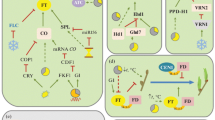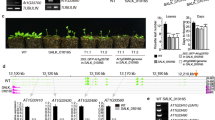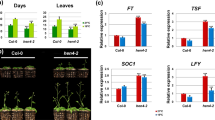Abstract
Transition from vegetative to reproductive development (flowering) is one of the most important decisions during the post-embryonic development of flowering plants. More than twenty loci are known to regulate this process inArabidopsis. Some of these flowering-time genes may act at the shoot apical meristem to regulate its competence to respond to floral inductive signals and floral evocation. Genetic and phenotypic analyses of mutants suggest that the late-flowering geneFT may be a good candidate for such genes. To test this, we have cloned theFT gene using aFT-deficiency line associated with a T-DNA insertion. Cloned genes and loss-of-function mutants in hand, it is now possible to analyse the role ofFT and other genes in flowering at the biochemical and cellular levels as well as at the genetic level. The deduced FT protein has homology with TFL1 and CEN proteins believed to be involved in regulation of inflorescence meristem identity. Phylogenetic analysis suggests that theFT group and theTFL1/CEN group of genes diverged before the diversification of major angiosperm clades. This raises the interesting question of the evolutionary relationship between the regulation of vegetative/reproductive switching in the shoot apical meristem and the regulation of inflorescence architecture in angiosperms.
Similar content being viewed by others
References
Araki, T. andKomeda, Y. 1993. Analysis of role of the late-flowering locus,GI, in the flowering ofArabidopsis thaliana. Plant J.3: 231–239.
Araki, T. andKomeda, Y. 1993. Flowering in darkness inArabidopsis thaliana. Plant J.4: 801–811.
Bai, S. andSung, Z.R. 1995. The role ofEMF1 in regulating the vegetative and reproductive transition inArabidopsis thaliana (Brassicaceae). Amer. J. Bot.82: 1095–1103.
Blázquez, M.A., Soowal, L.N., Lee, I. andWeigel, D. 1997.LEAFY expression and flower initiation inArabidopsis. Development124: 3835–3844.
Bradley, D., Ratcliff, O., Vincent, C., Carpenter, R. andCoen, E. 1997. Inflorescence commitment and architecture inArabidopsis. Science275: 80–83.
Clark, S.E. 1997. Organ formation at the vegetative shoot meristem. Plant Cell9: 1067–1076.
Coen, E.S. andNugent, J.M. 1994. Evolution of flowers and inflorescence. Development1994 Suppl.: 107–116.
Coupland, G. 1995. Genetic and environmental control of flowering time inArabidopsis. Trends Genet.11: 393–397.
Cove, D.J., Knight, C.D. andLamparter, T. 1997. Mosses as model systems. Trends Plant Sci.2: 99–105.
Evans, L.T. 1969. The Induction of Flowering: Some Case Histories. Cornell University Press, Ithaca, NY.
Furner, I.J., Ainscough, J.F.-X., Pumfrey, J.A., andPetty, L.M. 1996. Clonal analysis of the late floweringfca mutant ofArabidopsis thaliana: cell fate and cell autonomy. Development122: 1041–1050.
Goto, N. 1982. Conditions for flower bud formation in total darkness. Arabidopsis Inf. Serv.19: 55–62.
Hicock, L.G., Warne, T.R. andFribourg, R.S. 1995. The biology of the fernCeratopteris and its use as a model system. Int. J. Plant Sci.156: 332–345.
Jacobsen, S.E. andMeyerowitz, E.M. 1997. HypermethylatedSUPERMAN epigenetic alleles inArabidopsis. Science277: 1100–1103.
Kakutani, T. 1997. Genetic characterization of late-flowering traits induced by DNA hypomethylation mutation inArabidopsis thaliana. Plant J.12: 1447–1451.
Kakutani, T., Jeddeloh, J., Flowers, S., Munakata, K. andRichards, E. 1996. Developmental abnormalities and epimutations associated with DNA hypomethylation mutations. Proc. Natl. Acad. Sci. USA93: 12406–12411.
Koornneef, M., Hanhart, C.J., andvan der Veen, J.H. 1991. A genetic and physiological analysis of late flowering mutants inArabidopsis thaliana. Mol. Gen. Genet.229: 57–66.
Mandel, M.A. andYanofsky, M.F. 1995. A gene triggering flower formation inArabidopsis. Science377: 522–524.
Martínez-Zapater, J.M., Coupland, G., Dean, C. andKoornneef, M. 1994. The transition to flowering inArabidopsis.In E.M. Meyerowitz and C.R. Somerville, eds., Arabidopsis, Cold Spring Harbor Laboratory Press, Cold Spring Harbor, NY, pp. 403–433.
Meyerowitz, E.M. 1998. Genetic and molecular mechanisms of pattern formation inArabidopsis flower development. J. Plant Res.111: 233–242.
Napp-Zinn, K. 1985.Arabidopsis thaliana.In H.A. Halevy, ed., CRC Handbook of Flowering, CRC Press, Boca Raton, FL, Vol. 1, pp. 492–503.
Onouchi, H. andCoupland, G. 1998. The regulation of flowering time ofArabidopsis in response to daylength. J. Plant Res.111: 271–276.
Putterill, J., Robson, F., Lee, K., Simon, R. andCoupland, G. 1995. TheCONSTANS gene ofArabidopsis promotes flowering and encodes a protein showing similarities to zinc finger transcription factors. Cell80: 847–857.
Roldán, M., Gómez-Mena, C., Ruiz-Garciá, L., Martin-Trillo, M., Salinas, J. andMartínez-Zapater, J. 1997. Effect of darkness and sugar availability to the apex on morphogenesis and flowering time ofArabidopsis. Flowering Newsletter24: 18–24.
Ruiz-García, L., Madueño, F., Wilkinson, M., Haughn, J., Salinas, J. andMartínez-Zapater, J.M. 1997. Different roles of flowering-time genes in the activation of floral initiation genes inArabidopsis. Plant Cell9: 1921–1934.
Rédei, G.P., Acedo, G. andGavazzi, G. 1974. Flower differentiation inArabidopsis. Stadler Genet. Symp.6: 135–168.
Schoentgen, F. andJollès, P.J. 1995. From structure to function: possible biological roles of a new widespread protein family binding hydrophobic ligands and displaying a nucleotide binding site. FEBS Lett.369: 22–26.
Shannon, S. andMeeks-Wagner, D.R. 1991. A mutation in theArabidopsis TFL1 gene affects inflorescence meristem development. Plant Cell3: 877–892.
Simon, R., Igeño, M.I., andCoupland, G. 1996. Activation of floral meristem identity genes inArabidopsis. Nature384: 59–62.
Soppe, W., Alonso-Blanco, C., Koornneef, M. and Peeters, A.J.M. 1997. Cloning ofFWA and characterization ofEFS, two genes involved in floral induction inArabidopsis. 8th International Conference on Arabidopsis Research, Abstract #5-33.
Sung, Z.R., Belachew, A., Shunong, B. andBertrand-Garcia, R. 1992.EMF, anArabidopsis gene required for vegetative shoot development. Science258: 1645–1647.
Weigel, D. 1995. The genetics of flower development. Annu. Rev. Genet.29: 19–39.
Weigel, D. andNilsson, O. 1995. A developmental switch sufficient for flower initiation in diverse plants. Nature377: 495–500.
Weller, J.L., Reid, J.B., Taylor, S.A. andMurfet, I.C. 1997. The genetic control of flowering in pea. Trends Plant Sci.2: 412–418.
Yang, C.-H. and Haung, M.-D. 1997.EMF genes interact with late-flowering mutant genes to regulateArabidopsis floral competence. 8th International Conference on Arabidopsis Research, Abstract #5-31.
Yang, C.H., Chen, L.J. andSung, Z.R. 1995. Genetic regulation of shoot development inArabidopsis: role of theEMF genes. Dev. Biol.169: 421–435.
Yanofsky, M.F. 1995. Floral Meristems to floral organs: Genes controlling early events inArabidopsis flower development. Annu. Rev. Plant Physiol. Plant Mol. Biol.46: 167–188.
Author information
Authors and Affiliations
Rights and permissions
About this article
Cite this article
Araki, T., Kobayashi, Y., Kaya, H. et al. The flowering-time geneFT and regulation of flowering inArabidopsis . J. Plant Res. 111, 277–281 (1998). https://doi.org/10.1007/BF02512184
Received:
Accepted:
Issue Date:
DOI: https://doi.org/10.1007/BF02512184




